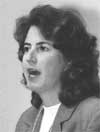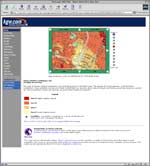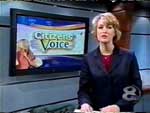Spring 2002
Civic TV Seeks Citizen Input
By Deb Halpern Wenger
Special to the Pew Center
 The signs are good. The economy is rebounding, and the high old times for television news are coming back, right? Well, let’s not go that far. TV newsrooms around the country are still struggling with hiring freezes, budget cutbacks and a “do more with less” mentality. But newsrooms with a commitment to civic journalism are doing some remarkable things despite the tough economic times. Here is a roundup of what’s happening.
The signs are good. The economy is rebounding, and the high old times for television news are coming back, right? Well, let’s not go that far. TV newsrooms around the country are still struggling with hiring freezes, budget cutbacks and a “do more with less” mentality. But newsrooms with a commitment to civic journalism are doing some remarkable things despite the tough economic times. Here is a roundup of what’s happening.
Making It Relevant
 Savannah’s WSAV-TV (NBC) is directly soliciting story ideas through e-mail and a dedicated phone line. News Director Kevin Brennan says “Your News 3” is making WSAV’s newscasts more relevant. “It’s an attempt to develop an editorial partnership with viewers, and it’s working,” he says. In its first 14 months, at least 2,500 viewers have responded. Many of the story ideas involve neighborhood issues, so every month WSAV profiles a different local neighborhood. The station sets up a meeting with residents to discuss problems and possible solutions and then does follow-up stories on those issues. Says Brennan, “Neighborhood leaders have told us our stories have made city officials stand up, take notice and help solve their problems.”
Savannah’s WSAV-TV (NBC) is directly soliciting story ideas through e-mail and a dedicated phone line. News Director Kevin Brennan says “Your News 3” is making WSAV’s newscasts more relevant. “It’s an attempt to develop an editorial partnership with viewers, and it’s working,” he says. In its first 14 months, at least 2,500 viewers have responded. Many of the story ideas involve neighborhood issues, so every month WSAV profiles a different local neighborhood. The station sets up a meeting with residents to discuss problems and possible solutions and then does follow-up stories on those issues. Says Brennan, “Neighborhood leaders have told us our stories have made city officials stand up, take notice and help solve their problems.”
WSAV is developing a Web site to help link neighborhoods and foster discussion about similar problems and possible solutions. A viewer advisory committee is also in the planning stages. Every few months, WSAV plans to invite community members to watch a newscast and provide feedback. Brennan says, “The one thing you keep hearing about the decline in news viewership is that people don’t believe the news is relevant. So what better way to find out what is relevant than to listen to the viewers?” Check out www.wsav.com/news/yournews/.
Doing it Daily
When KVOA-TV (NBC) in Tucson, AZ, received a consultant’s recommendation to ramp up coverage of education, the station decided to create a new franchise using what it had learned in a recent civic journalism project. Every night at 10 p.m., KVOA airs an education piece under the banner, “Eyewitness News 4 – Inside Our Schools.” The focus is on issue pieces and solutions to problems (www.kvoa.com/education/).
 The idea to accentuate issues and positive stories came about after a town hall sponsored by Tucson’s two daily newspapers and eight local television stations. “We learned that parental involvement applied to everyone and that it was the key to a child’s success in school,” says KVOA News Director Lisa Contreras. With the Arizona Daily Star, KVOA created a pledge sheet, printed in the paper and posted online. By signing the pledge and returning it to the paper or station, parents, businesses and community groups promise to do things to help improve Tucson schools. In return, they receive an “I Took the Pledge” bumper sticker. Several hundred people and organizations have signed up.
The idea to accentuate issues and positive stories came about after a town hall sponsored by Tucson’s two daily newspapers and eight local television stations. “We learned that parental involvement applied to everyone and that it was the key to a child’s success in school,” says KVOA News Director Lisa Contreras. With the Arizona Daily Star, KVOA created a pledge sheet, printed in the paper and posted online. By signing the pledge and returning it to the paper or station, parents, businesses and community groups promise to do things to help improve Tucson schools. In return, they receive an “I Took the Pledge” bumper sticker. Several hundred people and organizations have signed up.
KVOA and the Star are making plans for another civic initiative this summer to get parents involved in helping their children succeed in school. Contreras says, “Civic journalism is all about interaction with the community and empowering people to find their own solutions to problems.”
Polling with Partners
 KGW-TV (NBC) in Portland, OR, is wrapping up major growth and sprawl coverage with its Web partner and five area newspapers. “Your Neighborhood, Your Future,” began with a poll that showed a tension between Oregonians’ concerns about growth and the desire to bring in new business to stimulate a shaky economy.
KGW-TV (NBC) in Portland, OR, is wrapping up major growth and sprawl coverage with its Web partner and five area newspapers. “Your Neighborhood, Your Future,” began with a poll that showed a tension between Oregonians’ concerns about growth and the desire to bring in new business to stimulate a shaky economy.
The poll provided context for print and TV series, supplemented by the Web. At www.kgw.com/metro, users can type in their addresses to see how regional growth plans may affect their neighborhoods. KGW News Director Rod Gramer says, “It’s important to get a coalition together to give your stories greater impact and greater distribution. The multi-media experience gives the story more breadth.”
A mid-March grand finale was a live, hour-long special in which public officials and community residents interacted with each other and responded to e-mail and questions from about 100 in the audience.
Exploring the Issues
In Huntington, WV, the problem isn’t just holding on to audience, it’s holding on to people – period. West Virginia Public Broadcasting and The Herald-Dispatch are exploring why so many young people are leaving the state. The partners will hold facilitated discussions with college and high school students and ex-patriots throughout the state. The newspaper will do a series and WVPT will tape them for a May 2 special, “Home for Good.”
The show will include a group of experts responding live with possible solutions to concerns raised. WVPT General Manager Bill Acker says the idea is to get the entire state talking. “The May 2 program will be made available to all the radio and TV outlets in the state. In addition, The Herald-Dispatch will share its reporting with every newspaper in West Virginia.” www.wvhomeforgood.org.
Covering Racial Tensions
In April 2001, the police shooting of an unarmed teen-ager sparked riots in Cincinnati. In the aftermath, the Cincinnati Media Collaborative came up with an innovative way to partner while avoiding some of the hassles of a joint project. The Collaborative encompasses nearly all the city’s media outlets, including all the local TV stations and the two major newspapers in the market. Each television partner is working individually with the public station WCET to develop news specials or events – each taking the conversation on race to the next level.
For example, last September WCPO-TV (CBS) hosted a panel discussion on race with live studio audiences in three parts of the viewing area. “Things got pretty intense,” says News Director Bob Morford, “but what we did was provide a place for people to vent.” A couple months later, WKRC-TV (ABC) produced a special on realistic solutions for solving some of the city’s racial issues. WCET-TV President and CEO Susan Howarth says her station produced two more specials with print partners, one focusing on how to help educators deal with race relations in the schools. Go to www.wcet.org and click on the “Common Ground” icon.
In February, WLWT-TV (NBC) kicked off “On The Same Page.” The goal is to create a giant Cincinnati book club, getting as many people as possible to read “A Lesson Before Dying” by author Ernest J. Gaines. WLWT is sharing its public service announcements with all other stations to promote the project. The project wraps up in April when Gaines visits Cincinnati and WCET hosts a live call-in show with him.
Sticking With A Good Thing
 Talk about staying power, WTHR-TV (NBC) in Indianapolis proves that civic journalism works over the long haul. The station has been hosting community meetings and town halls for more than five years. Recently, the station partnered with The Indianapolis Star and local PBS affiliate WFYI to produce the 2002 “People’s Agenda.”
Talk about staying power, WTHR-TV (NBC) in Indianapolis proves that civic journalism works over the long haul. The station has been hosting community meetings and town halls for more than five years. Recently, the station partnered with The Indianapolis Star and local PBS affiliate WFYI to produce the 2002 “People’s Agenda.”
First, the partners surveyed Indiana residents to find what issues should be top priorities for the state legislature.A January town hall to discuss the issues was taped and broadcast on WTHR and a number of radio and public television stations across the state. “We wanted to give more people and more public officials the chance to hear what people in this state are concerned about,” says Young-Hee Yedinak, the project’s coordinator.
Bringing It Home
Taking complicated issues and defining them in human terms is what civic journalism is all about for some news organizations. KTVB in Boise (NBC), along with four Idaho print partners and public television, took on the task of exploring why rural Idaho was in financial crisis. Under the banner, “Rural Idaho: Challenged to Change,” KTVB produced an October series that focused on families affected by the tough economic times. Says KTVB News Director Tracy Brogden, “We told the emotional stories. We put the human face on the numbers and information.”
Iowa public television rolled KTVB’s pieces into an hour-long November discussion, including a viewer call-in segment, that aired statewide. To view a streamed version, log on to http://idahoptv.org/dialogue/past.html#806.
Shouldering Accountability
 At Tampa’s WFLA-TV (NBC), engaging viewers can also mean taking the heat from them. Last September, WFLA, with The Tampa Tribune and Tampa Bay Online, launched “Citizens’ Voice.” Here’s how it works: WFLA actively encourages viewers to comment on its journalism and any other issues involving the station. The comments are collected via phone and e-mail, then at 5:30 p.m. Thursdays, News Anchor Stacie Schaible reads and responds to a selection of those comments. “This stems from a desire to reach out to the public in new ways,” says News Director Forrest Carr. “It is all about what I believe is at the heart of civic journalism – getting people involved.”
At Tampa’s WFLA-TV (NBC), engaging viewers can also mean taking the heat from them. Last September, WFLA, with The Tampa Tribune and Tampa Bay Online, launched “Citizens’ Voice.” Here’s how it works: WFLA actively encourages viewers to comment on its journalism and any other issues involving the station. The comments are collected via phone and e-mail, then at 5:30 p.m. Thursdays, News Anchor Stacie Schaible reads and responds to a selection of those comments. “This stems from a desire to reach out to the public in new ways,” says News Director Forrest Carr. “It is all about what I believe is at the heart of civic journalism – getting people involved.”
Sometimes viewers criticize the news product. “When a member of our audience asks us a question about what we’re doing, we owe them an explanation,” Carr says.
The Tribune prints a “Citizens’ Voice” segment on Saturdays and TBO.com records many of the comments at http://newscenter.tbo.com/. The next step is a converged statement of principles for the News Center – the facility that houses all three. Carr says this is not a statement of ethics, but a statement of values shared by all three media outlets. The group is using citizen feedback to help frame the discussion, but there are no members of the public involved in creating the statement.
_______________________
Halpern Wenger is the former assistant news director for WFLA-TV, Tampa.
